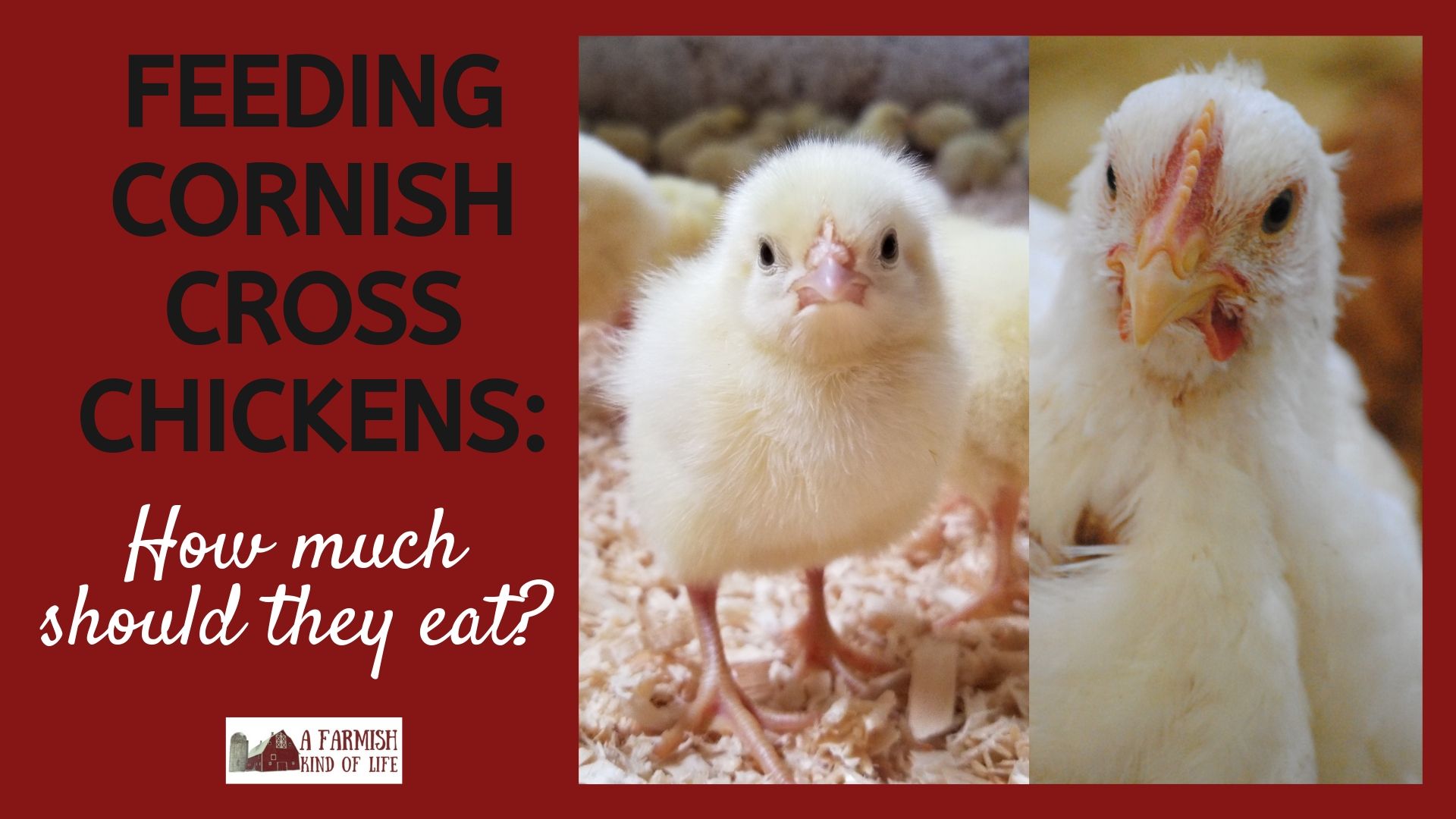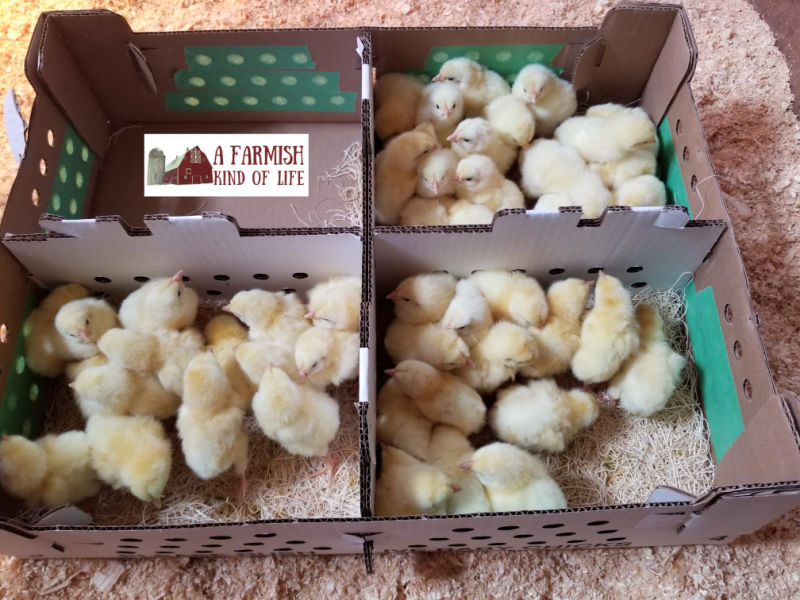Feeding Cornish Cross Chickens: How Much Should They Eat?

Podcast: Play in new window | Download
Subscribe: RSS
A Farmish Kind of Life is a participant in the Amazon Services LLC Associates Program, an affiliate advertising program designed to provide a means for sites to earn advertising fees by advertising and linking to Amazon.com. You can view our full affiliate disclosure here.
Feeding Cornish Cross chickens the right way is so important. If you overfeed them, you will end up with leg issues, heart attacks, and early death. So how much food should they eat? What does it cost to raise a Cornish Cross from day old chick all the way to freezer camp? Let me share with you the stats and tips I’ve learned after seven years of raising them.
(Listen to today’s podcast by clicking on the play button on the black player bar above, or find the Farmish Kind of Life podcast on your favorite podcast player!)
Amy, hold up. If Cornish Cross need such special care, why raise them? Why not raise a bird with more room for error?
We’ve tried other meat birds, but choose to raise Cornish Cross because when all is said and done, we get the most bang for our buck with this breed. Dollar in, dollar out, it’s the most efficient bird to raise for the meat you get.
If you’re trying to figure out what kind of meat bird is right for your homestead—because Cornish Cross aren’t always the best choice—you can check out my book Choosing the Right Meat Chicken for Your Homestead, which compares five different chicken breed options that are often suggested to raise for meat.
New to feeding Cornish Cross chickens?
If you are new to raising and feeding Cornish Cross chickens, you may not realize how different they are from other chicken breeds. Cornish Cross birds are bred to grow fast. If you don’t feed them correctly, they will grow too quickly and that’s when you start to see sloth like birds that do nothing but sit and wait at the food pan for their next meal—partly because they’re lazy, but also because they can’t walk due to leg issues. You will also have chickens die off early because their hearts can’t keep up with the growth.
The best way to explain Cornish Cross is by telling you about a dog we used to have when I was younger. He used to bring us his food bowl when he was hungry. We thought it was cute, so we’d refill it. Every. Single. Time.
You can imagine what happened.
Cornish Cross are like that dog because they will try to convince you every time they see you that they are hungry and need to eat and if you don’t feed them right now, they are going to die.
And so the first time you raise them (just like our first time raising them) you may find that you’re going through a ton of food—and totally overfeeding them. Which means they grow too fast. They have lots of issues. They die early.
So let’s talk about a better way to feed them.

Suggested stats for feeding Cornish Cross
Let’s be clear: you cannot free feed Cornish Cross. You have to pay attention to how much you are feeding them.
According to the back of the 50 lb bag of meat bird feed that we purchase, it states that (in a perfect world) in 8 weeks, 10-12 pounds of food will raise a Cornish Cross to a 5 lb. dressed product. (Dressed means feathers gone, insides gone, cleaned, bagged, ready for the freezer. Basically, what you’d be buying at the store if you went to purchase a whole bird for supper.)
So. 1 bird. 8 weeks. 10-12 pounds of feed = 5 lb dressed bird.
Which means—using the 12 lb per bird amount—50 birds would require 600 pounds of food total over the course of 8 weeks, or 12 (50 lb) bags of feed total.
Doing the math, if it is suggested that 12 bags of feed will raise up 50 Cornish Cross in 8 weeks, that means you’re feeding a little more than a bag a week to a flock of 50 birds. But is this realistic?
Well. Let’s see what we did.

Our stats for feeding Cornish Cross (CC)
In full disclosure, our stats are from CC raised in a very (very) large coop. My commentary on free ranging/chicken tractoring CCs is at the end of this blog post.
We started with 50 chicks. One died the day after shipping. It is not uncommon for this to happen. We raised 49 birds all the way to butcher day.
I fed 900 pounds (or 18 bags) to 49 birds in 8 weeks and had an average dressed weight of 5 lbs.
900 pounds is 300 pounds above what the suggested feeding is for 50 Cornish Cross—but I still ended up with a 5 lb dressed bird. 300 extra pounds of food equates to 6 pounds extra over the 8 week course of one bird’s life—which is .1 pound (or 1.6 ounces) extra per bird, per day.
Breakdown for feeding Cornish Cross
My measuring scoop is an ice cream bucket. In the first week of the chicks’ lives, I fed a total of three ice cream buckets for 49 birds. Each day that accounts to about half an ice cream bucket.
By 3 1/2 weeks, I was feeding two ice cream buckets, twice a day. I had four feeders in their very large area. and I would divide the two ice cream buckets of food between the feeders (so, half an ice cream bucket per feeder) both morning and after we ate supper. That’s all I fed them. It didn’t take them long to eat that food—but that’s all I fed them. At this rate, the birds went through a bag of feed every 2-3 days.
Note: Make sure they have water available all the time.

Breakdown for cost of feeding Cornish Cross
The 50 lb bag of meat bird feed that’s available locally to us is $14.50 per bag. I don’t feed organic or anything fancy, as it’s not readily available where I live—especially in the quantity I need.
18 bags x $14.50 each = $261.00
$261.00/48 birds butchered = $5.44 to feed each bird to butcher day (average)
On butcher day…
Be assured, on butcher day our chickens were still up walking around, totally active, and doing their chickeny things. Much healthier than an overfed Cornish Cross.
On butcher day, we ended up with 48 birds. We actually had 49, but after plucking one bird we found a giant discoloration (bruise?) spanning the entire length of one side of its body. Since we weren’t sure of the cause, we opted to not put that chicken in our freezer. So our remaining cost stats are figured for 48 birds, since that’s what was useable for our freezer.
48 birds = 242 pounds of meat
$261 feed cost/242 pounds of meat = $1.08 cost per pound of meat
$1.08 per pound x 5 lb average dressed bird = $5.40 to feed each bird to butcher day (average)
Cost per chick = $2.40
Our cost (feed plus chick) = $7.80 per bird in our freezer

Reducing costs when feeding Cornish Cross birds?
Can you free range Cornish Cross? Sure. We did one year and found with them moving more, they were actually more hungry (exercise!) and they grew slower. CC need a ton of protein—remember, they are a meat bird—so their free ranging success depends on what you have available for them to eat on your property. In our experience, CC still require a ration of a meat bird feed because of their protein needs.
Another option is to use a chicken tractor. Our experience with CC in a chicken tractor was that the tractor had to be moved more frequently than with other breeds because with a CC, a lot of food goes in and then a lot of food goes out. CC make a lot of droppings, so if you go this route, be prepared to move the tractor a lot.
Other ways to reduce feed costs are to supplement with kitchen scraps, grow fodder, or use fermented chicken feed. I will write more about these options in future posts.
Feeding Cornish Cross birds correctly makes a difference!
You can’t raise a Cornish Cross like you raise any other bird. But when you are careful with how you feed them, you will have a much better experience in raising them, and a full freezer because of it!
Links specifically mentioned in podcast episode #57
My youngest son’s YouTube channel
My book: Choosing the Best Meat Chicken for Your Homestead

Subscribe to my Farmish Kind of Life podcast at iTunes, Stitcher, Google Play, PlayerFM, or other popular podcast players. All episodes of the podcast will also be linked under the podcast tab that you can find way at the top of this post in my menu bar.







Interesting article, Amy. Like you, when it comes to meat, I think you get the best results with a broiler type chicken than with a heritage breed. Even heavy ones such as Plymouth Rocks, Buff Orpingtons or Brahmas are mostly bone, especially the breast. IMHO, I think you get the best bang for your buck meat-wise with ducks. Much better meat to bone ratio, plus ducks are sustainable. Meaning you can keep a few for breeding and produce your own ducklings every year rather than having to buy new babies each year, which is expensive. Another great thing about ducks is that they are hardy when it comes to adverse weather, diseases and parasites.
When you say an ice cream bucket are you referring to the plastic ones? We recently got 25 birds and are trying to decide how much to feed them. Any help would be great!
Yes, the one gallon plastic ice cream buckets. Thanks for asking!
Thank you for all the information. It definately helped me decide which birds I’m going to continue on my farm.
In my opinion $8.35 a bird is no different than the grocery store cost for whole uncut bird,. No to forget having all the work of the butchering, care etc . Not really sensible for me . Cornish cross unless they are going to be raised totally non GMO feed and that’s my point of raising my.own birds- food to begin with. Then a profit of the bird would be worth raising and raises retail to around $12.00 a bird or more. We here refuse to eat GMO anything so the grain the animal eats affects the human as well. Also could soak the grains over night to save money on the cost of non gmo feed.
So my family is raising some real multi purpose birds , such as the breed I was raised on. Rhode island reds. They lay eggs, get broody & reproduce or my muscovy hens will hatch them out. Lol no problem there. Or the hen will do it on their own. Plus these birds are ready to be harvested by fall if started early spring. Cost less to feed, they free range a lot, don’t have health issues and they taste totally awesome! I suppose if the farmer had a large family and needed to raise hundreds of. Birds to feed that family, Cornish cross would be perfect because they could several batches each growing season esp in the south. But for a small family of 4 or even just for a couple, The Rhode island reds multi purpose birds ismore economical and makes more sense. It’s great no buying of birds constantly from somewhere else outside the farm. Being self sustainable is not counting on an outside entity to provide . When the SHTF scenerio occurs, there won’t be Any freezers to store meat birds in anyway so having the ability to harvest as needed is smart thinking. Just a few things for folks to think about.
Is there an easy rule of thumb for daily feeding? Such as – birds have had enough food if they eat it within – 15 minutes, an hour, 2 hours? I’m only feeding twice a day, and they get outside some, but I don’t know how to tell if I’m feeding enough, as they continue to grow. Thanks
It’s tricky with Cornish Cross because in my experience they will honestly just keep eating whatever you put out. I went with what was on the back of the feed bag we buy, kept track daily, and the article is what our experience was. I’ve never known a Cornish Cross to be one to know that its belly is “full”. 😉
Good article. I was trying to find how to make my own feed instead of buying from the store. I’ve raised three sets of CC meat birds this summer with mixed results. The first chicks were butchered at 6 weeks. Not much meat on those. The second were butchered at 8 weeks and had a ton of breast meat but otherwise pretty bony backs and smaller legs and thighs. This batch is 2 weeks old and it’s September so i’m thinking maybe let them go one more week and see if this makes a difference in the amount of meat. We fed just what we could find at Tractor Supply the first time, organic grower the second time, and right now I’ve bought bags from TSC, non-organic. Organic is great but it’s soooo expensive. I guess we’ll see how this last batch goes. Not really happy with the taste and amount of meat so far. Thanks for your article, it helped with understanding price of raising vs buying at the store.
I’m glad you found the article helpful. The longer we have raised the CCs the more we’ve learned. It’s definitely a process to figure out what works best for you!
You say you use the ice cream bucket as your measuring scoop. Is that a half gallon, three-quarter, or gallon bucket?
Gallon bucket. I should have been more clear, I’ve only seen gallon buckets where I live so I though that was the norm! 😉
Your own math doesn’t make sense.
Where did you get 242 lbs. of meat? 48 x 5 lb. is 240 🤷♀️
$261 ÷ 242 lb. = $1.08, not $1.07.
How did you calculate $8.25 per bird in the freezer?
The numbers provided don’t add up.
You have two different numbers for cost of feed per bird,
one is $5.44 and the other is $5.35. Which is correct?
Any combination of the given numbers doesn’t add up to $8.25
I realize you are just giving averages but I’d like to know how you came up with these numbers.
Thank you for taking the time to record all of this data. It gets people thinking about the cost effectiveness of raising any animals used for food.
Thanks for your questions. To clarify:
The 48 birds we butchered were an *average* of 5 lbs a piece. After each bird is packaged, I weigh each bird and tally that weight. So the 242 pounds meat was the total weight of all birds together (which could have been 1 bird 4.8 pounds, 1 bird 5.4 pounds, etc), not a “48 birds butchered x each bird is 5 lbs.”
$261 divided by 242 pounds is $1.0785123967. (Oops. I forgot to round up.)
Using $1.08 per pound x 5 pound (average per bird), we get 5.40 per bird, much closer to the 5.44 cited in the article for the $261/48 birds butchered. I don’t know why they don’t come out to exactly the same when you compare “total cost of feed/birds butchered” to “cost per pound to feed x average weight of bird”.
You are correct that the original total cost per bird was incorrect at 8.25. The total cost per bird should be 7.80 (2.40 for the cost of the chick, 5.40 to feed out). I’ve made the adjustments to the article. 🙂
Thanks so much for the awesome info! Do you start your chicks on the broiler feed right from the beginning or do they get chick feed first?
We don’t feed chick starter at our farm, but you certainly can if you’d like!
Hi! What percent protein do you feed your broilers? Thanks for the information!
The broiler food available where we live is 21 percent protein. 🙂
I’m so ready to do this, but as with everything, I think I am over complicating it, and reading too many different opinions. I’ll rely on your practical experience, but I do have a couple questions if you have time. 1) Do you free feed for the first week, then cut down to 12 on and 12 off? I have read varying opinions from 1 week to the first 3 weeks. 2) I only have 18% protein chicken feed available, do you think this will work… where I live (HI), it runs about $25 per 50 lbs. However, I do have starter food at a slightly higher protein for a 40 lb bag at $22 each.
Looking to raise 15 birds just to see if I can do it, a total newb here. Thanks for you article.
Thanks for the questions! Yes, I basically free feed for the first week (meaning I will refill their feeder if I notice it’s empty). After that, I cut down to “hey, chicks, this is what you get today.” I know people who free feed for up to three weeks, I personally don’t.
Secondly, I have fed a batch of Cornish out on 17% protein (because that’s all that was available that year) and they did fine. They may be slightly more hungry and require a bit more food, but ours did fine. Also, wow — chicken feed is expensive where you live! If I were in your situation, I would go with the 18% protein and not worry about it. You can do the starter if you want (we don’t use a separate starter, but you certainly can!) — you will have to make that decision based on financials.
Also, know that some people will tell you you’re going to mess up your birds if you don’t feed them super high protein. Our experience is that a 17% protein feed got our birds to freezer just fine. 🙂 Good luck!